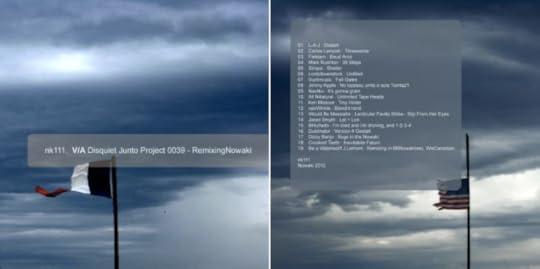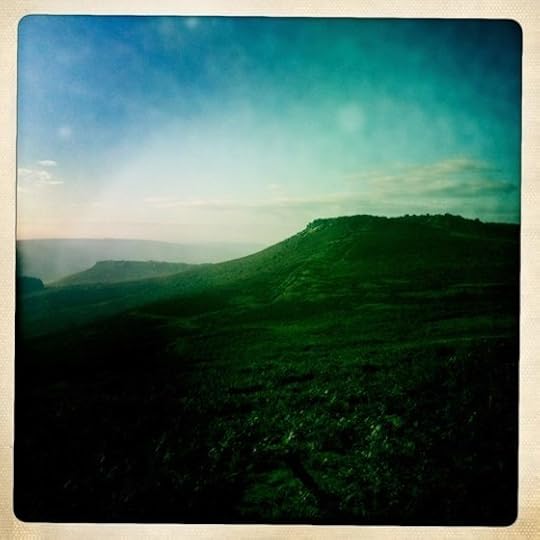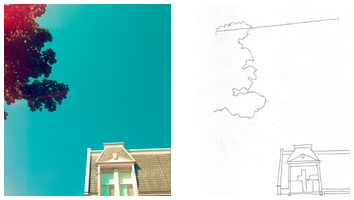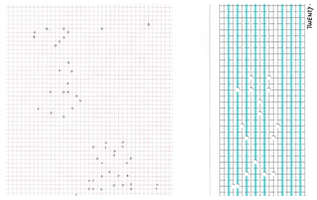Marc Weidenbaum's Blog, page 479
November 19, 2012
Modular Synth as Second Life (MP3)
“Démo sample” is how Miguel A. Garcia and Heddy Boubaker bill the brief duet they’ve posted, a relatively gentle and playful effort in purely synthetic and electronic sound. They explain that it’s “Promotional stuff for Tour 2013.” Garcia is credited with “raw electronics,” and Boubaker with “analog modular synth.” As Boubaker, a longtime free-improvising saxophonist, has explained, he needed to give up the wind instrument due to his health, and it’s been a fascinating listening experience as he’s made the modular synthesizer more and more his own instrument.
Track originally posted at soundcloud.com/hbbk. More on the musicians at xedh.org and boubaker.net.
November 16, 2012
Not Waving, Tubing (MP3)
There’s a strange dissonance — in the cognitive sense, not the harmonic — when tracking the progression of a short piece of ambient music as it flows across a browser. There’s the placid, even if dark-toned, audio on the one hand, and on the other there’s that rapid motion of the projected image, the symbol of the music’s forward motion. Take “Budapest,” by Moon Zero, which was posted at the artist’s soundcloud.com/moonzero page, and which has, as a waveform, the sort of largely uniform contour of a drone.
It’s a thick, unwavering stretch of sound, by all appearances. In colloquial terms, “Budapest” is more tube than wave. And, indeed, Moon Zero’s drone is a drone, in that it has a consistent tonal quality that maximizes stasis over any evident melodic or rhythmic intent. But there’s more to it than that, not only because drones entice the ear to listen for subtle distinctions, but because “Budapest”’s distinctions aren’t all that subtle: inside that tube there are cycles of ringing, metallic chatter, slurry echoes, and more. This waveform pattern is just one view of the track. Certainly there are other visualizations that would do greater justice to its complexity.
More on/from Moon Zero, who’s based in London, England, at twitter.com/moonzer0
and moon-zero.tumblr.com.
November 15, 2012
Disquiet Junto Project 0046: Silent Ballot

Each Thursday at the Disquiet Junto group on Soundcloud.com a new compositional challenge is set before the group’s members, who then have just over four days to upload a track in response to the assignment. Membership in the Junto is open: just join and participate.
The assignment was made in the afternoon, California time, on Thursday, November 15, with 11:59pm on the following Monday, November 19, as the deadline. (There are no translations this week.)
These are the instructions that went out to the group’s email list (at tinyletter.com/disquiet-junto).
Disquiet Junto Project 0046: Silent Ballot
This is a shared-sample project. It focuses on the intimacy of democracy, and in the process it touches on various interrelated contemporary anxieties, including the surveillance state, voter fraud, and digital privacy.
You are being provided an audio recording of someone voting during the recent U.S. presidential election. The MP3 file can be accessed here:
You will select a very short segment (between 1 and 5 seconds in length) of this recording and you will then investigate it for what might be called its “sonic fingerprint.”
To accomplish this goal you will stretch, loop, magnify, and otherwise probe the audio to reveal its unique properties.
The evidence of your investigation will take the form of a single track of audio, between 1 and 4 minutes in length. You can add whatever sounds you like in the process of developing your track, but the source audio should be prominent throughout.
Deadline: Monday, November 19, at 11:59pm wherever you are.
Length: Your finished work should be between 1 and 4 minutes in length.
Information: Please, when posting your track on SoundCloud, include a description of your process in planning, composing, and recording it. This description is an essential element of the communicative process inherent in the Disquiet Junto.
Title/Tag: When adding your track to the Disquiet Junto group on Soundcloud.com, please include the term “disquiet0046-silentballot” in the title of your track, and as a tag for your track.
Linking: When posting the track, be sure to include this information:
More on this 46th Disquiet Junto project at:
http://disquiet.com/2012/11/15/disqui...
More details on the Disquiet Junto at:
http://soundcloud.com/groups/disquiet...
Photo of voting during a blackout by Michael Ross of guitarmoderne.com.
Tangents: Holo Pledge, Post-Sandy Art, Ellis’ Soundscape, …
◼ Please consider backing (i.e., kickstarting) the magazine (or serial-book) project Holo, which focuses on the convergence of art, science and technology:
The publication is led by Alexander Scholz, Filip Visnjic (creativeapplications.net), and Greg J. Smith (vagueterrain.net). The Kickstarter campaign has some extraordinary pledge rewards: $400 gets you an original Zimoun “motor box,” for example.
◼ NYC Art Post-Sandy: Good news: Apex Art Gallery in Manhattan “sustained no damage” during superstorm Sandy (apexart.org). Apex is where the Disquiet Junto concert will be held on November 27 as part of Rob Walker’s “As Real as It Gets” exhibit. The exhibit’s opening is this evening, November 15. Bad news: Apex appears to be in the minority. Among the many institutions hurt by Sandy are the hallowed Kitchen on West 19th (“The theater and first floor lobby were hit hard,” according to its Facebook page), New Amsterdam Presents, which had recently moved into a 3,000 square foot space in Red Hook, Brooklyn (“our space was flooded with almost four feet of polluted sea water,” came word in a blog post at
newamsterdampresents.com), and Eyebeam (“we were inundated with water which filled our entire ground floor and caused severe damage to the building,” via eyebeam.org).
◼ Warren Ellis’ Soundscape: In a recent interview at the fine tech/gadget website theverge.com, author Warren Ellis (Transmetropolitan, Red, the forthcoming novel Gun Machine) as well as a frequent and ambient-leaning podcaster, makes note of generational shifts in the British soundscape:
For instance, here in Britain, the soundtrack of every single early morning (except Sundays) was the hum and crunch of a milk float. I don’t know if you had these in the States? Electric light vehicles stacked with crates of milk for doorstep delivery. Twenty years ago they were a permanent feature of the soundscape. Today they’re almost all gone, because home delivery got killed by cheap milk in supermarkets. So, if you’re of a certain age, there’s a gap in the ambient soundscape. That denotes futuricity (which may not be a word) just as strongly as the absence of great mountains of horseshit in our cities denoted a futuristic condition in the 1950s.
More from Ellis at warrenellis.com.
◼ In Brief: I now have an page, thanks to work on the documentary film The Children Next Door. I handled music supervision and share sound-design credit with the talented Taylor Deupree, who composed the film’s original music. More at thechildrennextdoor.com. The movie was directed by Doug Block and produced by Lynda Hansen. So far it has shown at three film festivals: the Hamptons, Denver, and DOC NYC. ◼ There wasn’t a lot of sonic activity in the second season finale of Alphas, though it’s worth noting that the homeless guy who instantaneously has his dormant powers woken up becomes another in the show’s growing ranks of third-tier mutant banshee Tuvan mercenaries. ◼ Fringe has, in its final season, been relatively quiet in terms of its own sonic intrigue, in contrast with past seasons — at least since the explicit delineation of music’s role during the first episode of the season. But in last week’s episode (“Through the Looking Glass and What Walter Found There”), there was a new central gadget, a battery-operated radio tuned to a specific frequency that will, by all appearances, play an important role. ◼ There’s now a Disquiet.com page at instagram.com/dsqt. ◼ In an NPR Morning Edition interview this week on the occasion of the 50th anniversary of A&M Records, Herb Alpert mentioned the role that Les Paul’s multitrack recording played as an inspiration to his own development of the Tijuana Brass sound: npr.org. (Note: it’s in the audio segment, not the text summary). ◼ I’m currently writing a book for the great 33 1/3 series about the Aphex Twin album Selected Ambient Works Volume 2. The publisher, Bloomsbury, has begun posting on its blog interviews with the authors of its forthcoming books. First up in this series is Pete Astor (the Loft, the Weather Prophets) talking about Richard Hell and the Voidoids’ Blank Generation. According to the tag at the bottom of the Astor article, my interview will be the next to appear, which is excellent. Both the Aphex Twin and Hell/Voidoids albums were released, it’s worth noting, on the same label in the United States: Sire Records (in 1994 and 1977, respectively).
November 14, 2012
Post-Production as Performance

Few if any of Dave Seidel’s recordings, which he does under the name Mysterybear, are recordings in the contemporary sense of the term, at least as far as music is concerned. They aren’t layered, edited, constructed, even though Seidel is, proudly, an electronic musician. Electronic music may have been born of the creative use of the studio as an instrument unto itself, but for Seidel that progression is best recognized by the studio’s employment — by electronic equipment’s employment — as an instrument of performance, not composition. Seidel’s work may still qualify as post-production for its own sake, but it’s post-production as performance. What follows is one of his most trenchant tracks to date, a fierce play of hair-trigger static in the service of an intense, compact approach to forward momentum.
He describes it as follows:
Unedited improvisation recorded directly to Zoom H4N. Made with Drone Lab, Digitech Grunge, 4ms/Repeater Noise Swash, Malekko Wolftone Chaos, Repeater matrix mixer, Behringer mixer, Ekdahl Moisturizer.
The picture up top depicts one of Seidel’s tools, the Noise Swash, made by Martin Freeman (who, according to Seidel, took the photograph).
Track originally posted for free download at soundcloud.com/mysterybear. More on/from Seidel/Mysterybear at mysterybear.net and twitter.com/daveseidel. He lives in Peterborough, New Hampshire.
November 13, 2012
As Real As It Gets / As Real As It Sounds
Notes on the sound design produced by the Disquiet Junto over a series of projects for the exhibit “As Real As It Gets,” organized by Rob Walker for the gallery apexart in Manhattan. The exhibit runs from November 15 – December 22, 2012. More at designobserver.com and apexart.org. There will be a live concert of music from the exhibit at 6:30pm on Tuesday, November 27.
In his novel Au Bonheur des Dames (1883), Émile Zola (1840 – 1902) depicted the rise of the modern department store during the waning years of the 19th century. He did so in terms that seem more futurist than realist: “There was the continuous roar of the machine at work, of customers crowding into the departments, dazzled by the merchandise, then propelled towards the cash-desk. And it was all regulated and organized with the remorselessness of a machine: the vast horde of women were as if caught in the wheels of an inevitable force.” Or perhaps, more to the point, Zola was simply being realistic about the future. The book is rich with sonic depictions of the intensity of retail goings-on — not only the noisy machinations of capitalism in action, but the weighty silences that punctuate human communication.

As part of the “As Real As It Gets” exhibit, the online music collective known as the Disquiet Junto explored the nature of sonic activity in large-scale retail spaces. The Disquiet Junto is a freeform group of musicians — approximately 250 as of this writing, located around the globe — who take on weekly music projects; with Fluxus and Oulipo as guides, they employ creative restraint as a springboard for productivity. Between September and November of 2012, a series of assignments spurred the Disquiet Junto members to probe the acoustics of commerce from distinct vantages.
• The first of these assignments Disquiet Junto Project 0037: Store Recordings involved the collection of raw field recordings from retail spaces. These include, among other locations, a London, England, shopping center; a Macy’s in Boston, Massachusetts; a department store in Shibuya, Tokyo; an Apple Store in Boulder, Colorado; a market in Nonthaburi, Thailand; and a Target in Simi Valley, California.
• The second assignment Disquiet Junto Project 0038: Zola’s Foley asked the Disquiet Junto members to create fake field recordings, artificial environments: sounds that suggest retail spaces but were created from whole cloth. This project employed the foley techniques of motion pictures and television.
• The third assignment (Disquiet Junto Project 0043: Dazzled Machine) asked the Disquiet Junto members to remix the material accumulated during the first two assignments. The proposed goal was to approximate the mechanistic fury inherent in Zola’s novel.
• And for a fourth side project, a handful of Disquiet Junto members produced brief, seductive sonic cues for an imagined contemporary franchise of The Ladies’ Paradise / Au Bonheur des Dames department store.
The combined 2.7 hours of sounds will be heard in an ongoing state of shuffle throughout the run of “As Real As It Gets.” Imaginary and documentary soundscapes will challenge each other’s sense of reality. Remixes will run up against the raw materials from which they were forged. And on occasion a voice will beckon the gallery visitor to The Ladies’ Paradise for the latest blue-light special.
This set is comprised of material selected from the above project by Rob Walker, the exhibit’s organizer:
The following is a list of the more than 40 members of the Disquiet Junto whose sounds are heard in this project: Adam Baker (Deadwood), afterpostmodernism (Ian Campbell), all n4tural, Benjamin Dauer, bigpause, Carlos Lemosh, Charlie Grant, Damon Holzborn, Dean Terry, DEMILIT, Dick Mitic, Dizzy Banjo, echosonic (Grant Weston), Emma Hendrix, Ethan Hein, Inlet (Corey K.), jai_, jmmy kpple, James Ross, Justin Buckley, Ken Mistove, Lem Herlihy, lordofoverstock (Matthew Austin), Mark Rushton, Michel Bananbila, mjh 7, Moody Alien (Thessaloniki), Natalia Kamia, Naotko (Naoyuki Sasanami), Random Coil, SIGHUP (Steven Hamann), simpsi, Steve Burnett, Summer of Nebula, Super Miracle Dream Team, The Holocene (Pj Hamlin), Tuonela, vanWinkle (Neal B Johnson), vuzhmusic (C. Reider), Westy Reflector, and Zedkah.
The Disquiet Junto is moderated by its founder, Marc Weidenbaum (Disquiet.com). Special thanks to Rob Walker, apexart, Antonin Gaultier, Hunter Hayden, Cameron Maddux, Cullen Miller, Carl Ritger, Paolo Salvagione, Ellen Shakespeare, Stephen Vitiello, Boon Design, dstl.info, Futureprüf, SoundCloud.com, Twitter.com, WordPress.org, the students in the fall 2012 semester of the course ADV 499-30 (“Sounds of Brands / Brands of Sounds”) at the San Francisco Academy of Art, and the members of the Disquiet Junto.
The Sound of Oramics (MP3)
Field recordings don’t only take place in fields. Or more to the point, sometimes the field of study is indoors. And sometimes the field of study is itself a field of study. Savaran’s “Oramica” captures the electronic afterglow, the sonic byproduct, of a gallery exhibit itself dedicated to electronic sound. It’s an eight-plus-minute record of Oramics to Electronica: Revealing Histories of Electronic Music, an exhibit that began its run at the British Science Museum in July 2011 and concludes on December 1 of this year. Savaran’s track isn’t a pure field recording. It’s a distillation of the initial document, with additions from Savaran himself.
Here’s Savaran’s description of his process:
This track is based around an 8 minute field recording of the sounds in the Science Museum, London during the Oramics to Electronica. … The exhibition is on the 2nd floor of what is essentially a long open hall, so sound carried from all floors. I sat at the front of the second floor facing the Oramics exhibition and recorded everything that could be heard into a Sony PCM M-10 recorder. Some parts of the exhibition were playing individual electronic sounds and the oramics sounds could also be heard over headphones while using an interactive screen.
I mixed the field recording with sounds from Reaktor and Kore2 blended in such a way that the Oramics sounds and field recording appear to seemlessly fit into the overall soundscape.
Among the materials on display are the instrument that composer Daphne Oram called her Oramics Machine, and an EMC VCS3 synthesizer of the sort utilized by Oram’s one-time employer, the BBC Radiophonic Workshop.
Here’s a video produced by Science Museum about the exhibit:
Track originally posted for free download at soundcloud.com/savaran. Savaran is Mark Walters, who’s based in Wales in the U.K. More on/from him at twitter.com/Savaran_Music and savaranmusic.wordpress.com. More on the Oramics exhibit at sciencemuseum.org.uk/oramics.
November 12, 2012
Netlabel Derivations, Collected (MP3s)

“All these bottles thrown into the sea eventually found recipients.” So read a brief note from Marc Jolibois of the France-based netlabel Nowaki. The phrase was his poetic and succinct summary of what had occurred — which is that the combined efforts of the Disquiet Junto members had, back in late September, taken several tracks released on Nowaki and combined them into new, original works.
The Nowaki netlabel was selected for the Juno project for a simple reason: while there are many netlabels (some 500 or so active ones at this stage, releasing music intentionally for free download), and while their practice embraces the Creative Commons, very few go the next step and make their music available for the production of derivative works. Nowaki is the sadly rare exception. So it was that, in the end, 19 Disquiet Junto members went to work on a handful of Nowaki tracks.
Read the original instructions for the project: “Netlabel Derivations.” Download the Nowaki compilation as a Zip archive. View, and stream, the set at nowaki-music.org and here:
“All these bottles thrown into the sea eventually found recipients” — and those recipients took the bottles, combined their contents, and filled the bottles anew with the concoctions.
November 11, 2012
Geologic Time, Sped Up (MP3)

Mark Ward almost titled this nine-minute mix of drone and pulse “Three Chords in Geological Time.” Instead he went with “From Sea to Sierra.” The latter is arguably the better of the two titles for various reasons. Like the “Geologic Time” title, “Sea to Sierra” hints at the sense of movement, but it better allows for the pacing of the actual track. Drones can be especially static, and this drone-based composition is anything but. The key thing here is that “geologic” simply doesn’t apply to the kind of shifting and modulating and development that occurs within the piece, how extended tones and rough textures and beading percussion shift in relative emphasis. There’s nothing “geologic” about the momentum of Ward’s piece, except in the way that we often see geologic time sped up to display change in a manner that the human brain can process, watching continents split and mountains rise in seconds rather than eons.
Do read the note that accompanies the track at soundcloud.com/mark-ward, where it was posted for free download. Ward makes it plainly clear that this is something of a breakthrough for him. The challenge he’d long faced was, in his words, “How on earth do you make those giant droning sounds?” It’s evident that he has found his own answer.
More on/from Ward at mark-ward.org and twitter.com/words_are_wild.
November 10, 2012
Grid Music (MP3s)


Disquiet Junto projects have yielded fascinating results, and high on the list is what Karl Fousek, aka analogue01, calls his Grid Music system. The system has two parts: one in which an image is encoded on graph paper, and another in which the resulting pattern is treated like an antique punch-card system. Part one is illustrated by the transition in the four images up top, and part two in this shot here:

All five of those images are from a recent post on Fousek’s website in which he describes the Grid Music system in full. It originates back with the 19th Disquiet Junto project, when the participants interpreted a photo by Yojiro Imasaka as if it were a graphic score.
Here are three gently percussive Grid Music tracks, all of them the result of processing “photographs of urban skylines in Montreal,” where Fousek lives:
Track originally posted for free download at soundcloud.com/analogue01. More on the system at karlfousek.com/grid-music.



